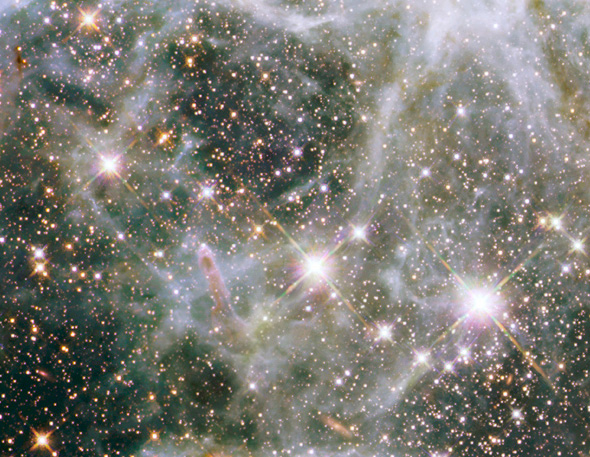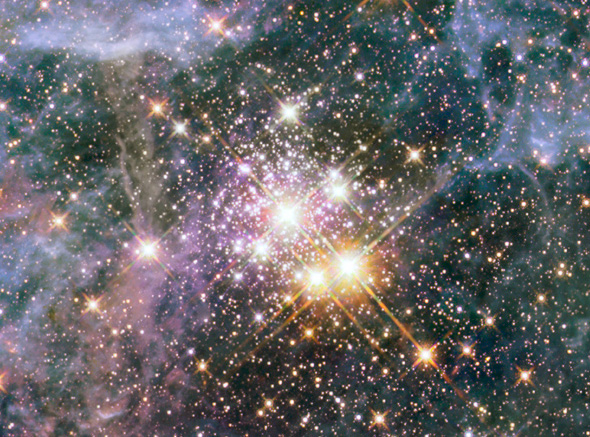Another Stunning Hubble Photo of a Vast Cloud of Gas and Dust
What you’re seeing is the Tarantula Nebula,
an unimaginably huge star-forming gas cloud. It’s located in the Large
Magellanic Cloud, a satellite galaxy to the Milky Way, about 170,000
light years away (as usual, you can grab a bigger shot, or even a ridiculously huge 16,600 x 15,000 pixel version).
The picture looks a bit odd to me, but that’s because it’s a mix of
visible and infrared light. This strongly accentuates gas and dust, and
gives the nebula that overall pinkish color in the picture. (I’ve
written about this nebula many times; see Related Posts below for more eye and brain candy.)
The Tarantula is one of the largest star-birth factories known,
busily churning out hundreds of thousands of stars. Most nebulae produce
stars in far smaller numbers. The Tarantula is so fecund, in fact, that
astronomers think it may actually be creating a globular cluster,
a massive spherical collection of stars. Most of these are very old
(like billions of years old), so being able to see one in the process of
formation is a real boon.
There’s so much to see in that image! Let me point out a few highlights.

First, right at the brightest part of the nebula (left of center in
the big picture, detailed above) you can see a clump of stars. That’s R136,
the main cluster of stars in the nebula. Several of the stars in it are
huge, about 100 times the mass of the Sun. Stars get hotter the more
massive they are, and those stars are so big they’re on the edge of
tearing themselves apart. The cluster provides most of the energy
lighting up this gas cloud, which is pretty impressive given that the
Tarantula is 650 light years across!
In the main image, see the two curves at the bottom, like a stretched-out W?
Those are the edges of gigantic cavities in the cloud, carved out by
the fierce light from the stars in R136. It eats into the gas and dust,
eroding it, leaving those weird shapes like fingers and sandbars in a
stream. In fact, when you zoom in, you can see more evidence of this:

That finger of gas on the left points directly at the cluster
(“upstream”) and is what’s left after the erosion. There’s probably a
denser knot of material at the tip, which has protected the material
“downstream.” Sometimes that’s where stars are born, though in the
powerful and deadly environment of the Tarantula, it’s possible all the
gas will be stripped away before any stars can properly get going.
The carving out of bubbles is happening on smaller scales, too; to the far right in the main photo is this little guy:

You can see a small bubble on the right, almost certainly being blown
by the winds and light of the stars forming inside it. That looks to me
like a decent-sized gas cloud—20–30 light years across or so—but it’s
positively dwarfed by the magnificence to the left. That seems unfair,
but the Universe doesn’t really care about artistic justice.
R136 is not the only cluster of stars in the nebula. To the upper
left in the main photo is another tight collection of stars, called Hodge 301:

As you can see, there doesn’t seem to be much gas and dust around the
cluster; it’s probably been cleared out by the stars within. Not only
that, but Hodge 301 is somewhat older than R136 (probably 20 million
years or so) which means many of its stars have already exploded, gone
supernova, which has no doubt helped blow away material around the site.
That’s just a taste of what’s going on here. There’s much more to
see, and I leave it to you to scan the high-res image and discover what
lies inside. It probably won’t surprise you to learn that many
astronomers have devoted their entire careers to studying this massive
and rich nebula. Looking over this picture, it’s easy to think there are
far worse ways to spend your life.
All photos by NASA, ESA, E. Sabbi (STScI)




No comments:
Post a Comment